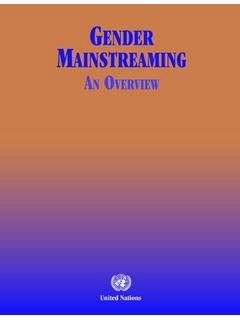Transcription of NHS England response to the specific duties of the ...
1 NHS England response to the specific duties of the equality Act equality information relating to public facing functions January 2016. OFFICIAL. Document Title: NHS England response to the specific duties of the equality Act Subtitle: equality information relating to public facing functions Version number: First published: January 2016. Classification: OFFICIAL. 2. OFFICIAL. Contents Contents .. 3. 1 Introduction- purpose of the report .. 4. 2 What Evidence Tells Us .. 4. 3 equality and Diversity Council .. 5. 4 Workforce Race equality Standard .. 6. 5 equality Delivery System .. 6. 6 How have we engaged with people from different protected groups? .. 6. 7 Learning Disabilities.
2 8. 8 Strategic Partner Programme .. 8. 9 Accessible Information .. 9. 10 Citizen Assembly .. 10. 11 Gender Identity Services .. 10. 12 equality Objectives .. 11. 3. OFFICIAL. 1 Introduction- purpose of the report NHS England is committed to high quality care for all, now and for future generations.' We know from evidence that we cannot be successful in achieving this vision without advancing equality and tackling health inequalities. Alongside this values-based commitment sit our legal duties to promote equality as required by the equality Act 2010, and to address health inequalities, as required by the Health and Social Care Act 2012. The public sector equality Duty that is set out in the equality Act 2010 requires public authorities, in the exercise of their functions, to have due regard to the need to: Eliminate unlawful discrimination, harassment and victimisation and other conduct prohibited by the Act.
3 Advance equality of opportunity between people who share a protected characteristic and those who do not. Foster good relations between people who share a protected characteristic and those who do not. The purpose of this report is to provide equality information on how NHS England is meeting the requirements of the specific duties of the equality Act in its public facing functions. Since its inception in April 2013, NHS England has undertaken considerable work to meet its moral and legal obligations to promote equality and address health inequalities to improve access to services, patient experience, and health outcomes for the population of England . NHS England also publishes its workforce data by protected characteristics on an annual basis.
4 2 What Evidence Tells Us Available data shows that there are inequalities in access, health outcomes and service experience which have endured over time despite substantial investment in healthcare. Inequalities are in evidence between groups of people with different characteristics and across geographies. For example: - The GP Patient Survey shows variation by ethnicity in patient confidence and trust in their GP, (white) British 66%, compared with Chinese 44%, Bangladeshi 52% and Pakistani 52%. This variance by ethnicity was replicated in the same survey in terms of overall experience of GP experience. (white) British 45%, compared with Chinese 23% and Bangladeshi 27%. - Gay and Lesbian people are times more likely than heterosexual people to report being a regular smoker.
5 Bisexual people are times more likely than heterosexual people to report being a regular smoker. - Gay and lesbian people are times more likely than heterosexual people to report a long-term mental health problem. Bisexual people are times more likely than heterosexual people to report a long-term mental health problem. 4. OFFICIAL. - Gay and Lesbian people are times more likely than heterosexual people to report some level of anxiety or depression. Bisexual people are times more likely than heterosexual people to report some level of anxiety or depression. - Within the children and young people inpatient and day case survey, 45% of parents and carers of children with a physical disability, and 49% of those with children with a mental health condition or learning disability, said that staff were definitely aware of their child's medical history.
6 This compared with 59%. of parents and carers whose children did not have these needs. This information will be used to help inform service planning. We will also use it as an evidence base for setting and equality objective which seeks to improve our engagement with people from different protected groups. 3 equality and Diversity Council NHS England is committed to a joined up approach to promoting equality and reducing health inequalities, and co-chairs the equality and Diversity Council (EDC), The EDC works to bring people and organisations together to realise a vision for a personal, fair and diverse health and care system, where everyone counts and the values of the NHS Constitution are brought to life.
7 The Council's purpose is to shape the future of health and social care from an equality health inequalities and human rights perspective and to improve the access, experiences and health outcomes and quality of care for all who use and deliver health and care services. During 2015, EDC membership was reviewed and a work plan scoped for 2015-17. As a result additional focus has been brought upon continued improvements in the access, experience and outcomes of people with protected characteristics from Inclusion Health1 groups. The EDC has made two significant decisions which have seen equality mandated in the NHS Standard contract for providers. These are to introduce a Workforce Race equality Standard (WRES), requiring all NHS organisations to demonstrate progress to ensure that employees from BME backgrounds have equal access to career opportunities and receive fair treatment in the workplace, including a specific indicator to address the low levels of NHS BME Board representation, and to make the use of the equality Delivery System (EDS2) compulsory for all NHS organisations.
8 EDS2 is a facilitative tool which supports NHS organisations to meet the Public Sector equality Duty (PSED). The evaluation of the first year of the WRES will inform the development of a wider programme of equality across the protected groups. Research exploring the experiences of disabled staff in the workplace was commissioned by NHS England and published by the Universities of Middlesex and Bedfordshire in January 2016. 1. Inclusion Health groups are marginalised socially excluded groups who experience poor health outcomes. They include, migrants and asylum seekers, homeless, sex workers, and gypsies and travellers 5. OFFICIAL. The EDC has agreed to carry out engagement and a campaign of service action with the wider NHS, to prepare for the introduction of a Workforce Disability equality Standard (WDES), potentially from April 2017.
9 Engagement has commenced with equality networks and disabled staff leading activity and workshops to promote disability as an asset' and discuss the research findings. The EDC is supported and hosted by the equality and Health Inequalities Unit. 4 Workforce Race equality Standard The WRES requires organisations employing almost all of the million NHS workforce to demonstrate progress against a number of indicators of workforce equality , including a specific indicator to address the low levels of BME Board representation. Following the inclusion of WRES within the NHS standard contract in April 2015, a substantial amount of work has been undertaken to support local NHS organisations in implementing the WRES, including support in meeting the milestone for NHS.
10 Provider organisations returning baseline WRES data. As the work progresses, a programme of work is scheduled to help ensure that organisations are fully supported to meet their contractual obligations and show continuous improvements against the WRES metrics. 5 equality Delivery System The main purpose of the EDS2 is to help local NHS organisations, in discussion with local partners including local communities, review and improve their performance for people with characteristics protected by the equality Act 2010. By using the EDS2, NHS organisations can also be helped to deliver on the Public Sector equality Duty (PSED). NHS England is committed to implementing the equality Delivery System, both as a system leader, and as an organisation in its own right.














